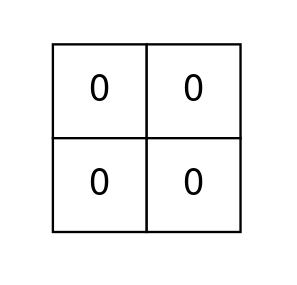Welcome to Subscribe On Youtube
2174. Remove All Ones With Row and Column Flips II
Description
You are given a 0-indexed m x n binary matrix grid.
In one operation, you can choose any i and j that meet the following conditions:
0 <= i < m0 <= j < ngrid[i][j] == 1
and change the values of all cells in row i and column j to zero.
Return the minimum number of operations needed to remove all 1's from grid.
Example 1:

Input: grid = [[1,1,1],[1,1,1],[0,1,0]] Output: 2 Explanation: In the first operation, change all cell values of row 1 and column 1 to zero. In the second operation, change all cell values of row 0 and column 0 to zero.
Example 2:

Input: grid = [[0,1,0],[1,0,1],[0,1,0]] Output: 2 Explanation: In the first operation, change all cell values of row 1 and column 0 to zero. In the second operation, change all cell values of row 2 and column 1 to zero. Note that we cannot perform an operation using row 1 and column 1 because grid[1][1] != 1.
Example 3:

Input: grid = [[0,0],[0,0]] Output: 0 Explanation: There are no 1's to remove so return 0.
Constraints:
m == grid.lengthn == grid[i].length1 <= m, n <= 151 <= m * n <= 15grid[i][j]is either0or1.
Solutions
-
class Solution { public int removeOnes(int[][] grid) { int m = grid.length, n = grid[0].length; int state = 0; for (int i = 0; i < m; ++i) { for (int j = 0; j < n; ++j) { if (grid[i][j] == 1) { state |= 1 << (i * n + j); } } } Deque<Integer> q = new ArrayDeque<>(); q.offer(state); Set<Integer> vis = new HashSet<>(); vis.add(state); int ans = 0; while (!q.isEmpty()) { for (int k = q.size(); k > 0; --k) { state = q.poll(); if (state == 0) { return ans; } for (int i = 0; i < m; ++i) { for (int j = 0; j < n; ++j) { if (grid[i][j] == 0) { continue; } int nxt = state; for (int r = 0; r < m; ++r) { nxt &= ~(1 << (r * n + j)); } for (int c = 0; c < n; ++c) { nxt &= ~(1 << (i * n + c)); } if (!vis.contains(nxt)) { vis.add(nxt); q.offer(nxt); } } } } ++ans; } return -1; } } -
class Solution { public: int removeOnes(vector<vector<int>>& grid) { int m = grid.size(), n = grid[0].size(); int state = 0; for (int i = 0; i < m; ++i) for (int j = 0; j < n; ++j) if (grid[i][j]) state |= (1 << (i * n + j)); queue<int> q{ {state} }; unordered_set<int> vis{ {state} }; int ans = 0; while (!q.empty()) { for (int k = q.size(); k > 0; --k) { state = q.front(); q.pop(); if (state == 0) return ans; for (int i = 0; i < m; ++i) { for (int j = 0; j < n; ++j) { if (grid[i][j] == 0) continue; int nxt = state; for (int r = 0; r < m; ++r) nxt &= ~(1 << (r * n + j)); for (int c = 0; c < n; ++c) nxt &= ~(1 << (i * n + c)); if (!vis.count(nxt)) { vis.insert(nxt); q.push(nxt); } } } } ++ans; } return -1; } }; -
class Solution: def removeOnes(self, grid: List[List[int]]) -> int: m, n = len(grid), len(grid[0]) state = sum(1 << (i * n + j) for i in range(m) for j in range(n) if grid[i][j]) q = deque([state]) vis = {state} ans = 0 while q: for _ in range(len(q)): state = q.popleft() if state == 0: return ans for i in range(m): for j in range(n): if grid[i][j] == 0: continue nxt = state for r in range(m): nxt &= ~(1 << (r * n + j)) for c in range(n): nxt &= ~(1 << (i * n + c)) if nxt not in vis: vis.add(nxt) q.append(nxt) ans += 1 return -1 -
func removeOnes(grid [][]int) int { m, n := len(grid), len(grid[0]) state := 0 for i, row := range grid { for j, v := range row { if v == 1 { state |= 1 << (i*n + j) } } } q := []int{state} vis := map[int]bool{state: true} ans := 0 for len(q) > 0 { for k := len(q); k > 0; k-- { state = q[0] if state == 0 { return ans } q = q[1:] for i, row := range grid { for j, v := range row { if v == 0 { continue } nxt := state for r := 0; r < m; r++ { nxt &= ^(1 << (r*n + j)) } for c := 0; c < n; c++ { nxt &= ^(1 << (i*n + c)) } if !vis[nxt] { vis[nxt] = true q = append(q, nxt) } } } } ans++ } return -1 }